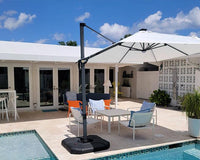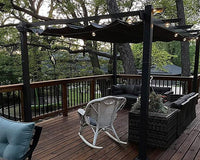A patio umbrella is not just a provider of shade, but a focal point that has the potential to define the style and comfort of your outdoor room. The placement of it will make all the difference in how effectively it shades the spots you need it to and how well it integrates with your patio décor. As you've learned, having a usable and inviting outdoor space makes all the difference. So let's examine the key considerations for placing your patio umbrella in an optimal way.
Sun Movement: The Key to All-Day Shade
The simplest rule for the placement of patio umbrellas is understanding how the sun moves across your sky throughout the day. The ideal placement for morning shade can expose you in the afternoon.
Go to your patio at different times of the day: mid-morning, noon, and late afternoon. Notice what receives the most direct sun and where shade would be most appreciated during the times you occupy the space most. This will determine your starting placement strategy. For instance, if you use your patio dining table mostly for dinner, western sun exposure will be your main issue.
Choose the Right Type of Umbrella for Your Space and Needs
The type of patio umbrella you have will significantly influence its placement options and effectiveness.
Center Pole Umbrellas
These are the classic design, with a straight pole that fits through a hole in a patio table or into a weighted base.

- Placement with Tables: When used with a dining table, the placement is straightforward – centered in the table. The key here is ensuring the umbrella is large enough to shade the entire seating area around the table during peak sun.
- Freestanding Placement: With a sufficiently heavy base, a center pole umbrella can be placed to shade lounge chairs or a conversation area. You'll have more flexibility here to move it as the sun shifts, provided the base is manageable.

Cantilever (Offset) Umbrellas
Cantilever umbrellas have a curved or hinged pole to one side, allowing the canopy to extend over an area without a central pillar. This makes them very flexible.
Best for Flexible Shading: These function well for shading enormous seating spaces, outdoor sofas, or hot tubs where a middle pole will be obtrusive. The base is large and heavy, so careful initial placement is imperative. Most cantilever designs have rotation and tilt features to allow you to modify the direction of the canopy throughout the day from a fixed base position.
Strategic Placement for Maximum Shade Coverage
Once you understand sun patterns and your umbrella type, apply the following tactics:
Put Key Activity Zones First
Where do you spend most of your time on your patio? The dining space, outdoor sofa, or a particular lounge chair? Place your umbrella to provide greatest shade to these high-traffic, high-use zones during periods when they are most utilized.
Consider Prevailing Wind Direction
While primarily for shade, wind is a factor. Placing an umbrella where it might catch strong, consistent gusts can lead to damage or instability, even with a good base. If your patio has a known windy side, try to position the umbrella so that structures (like your house) can offer some windbreak, or ensure the umbrella is always closed when not in use or during breezy conditions.
Utilizing Tilt and Rotation Features
If your umbrella has tilt or rotation capabilities (common in cantilever models, but also found in some center pole designs), factor this into your placement. A well-positioned base combined with these features allows you to adapt the shade coverage significantly as the sun moves, without needing to relocate a heavy base.Understanding how to adjust these features is key to maximizing your shade options.

Aesthetic Considerations: Integrating the Umbrella into Your Patio Design
Beyond pure function, your patio umbrella should also enhance the visual appeal of your outdoor space.
Balance the Space
Think of the umbrella as a significant visual element. Its placement can help balance the overall look of your patio. A large umbrella can anchor a seating area, while a smaller one might add a pop of color or a point of interest. Avoid placing it where it feels cramped or obstructs key walkways or views unnecessarily.
Color and Style Coordination
Choose an umbrella canopy color and pole finish that complements your existing patio furniture, cushions, and even your home's exterior. Does it blend in harmoniously, or does it provide a deliberate, stylish contrast? The umbrella's style—be it modern, traditional, or tropical—should also align with your overall outdoor decor theme.

Create a Focal Point or Defined Zone
An umbrella can help define a specific "room" or zone within a larger patio. For example, an umbrella over a dining set clearly designates that area for meals, while another over a pair of lounge chairs creates a distinct relaxation spot.
Safety and Stability: Non-Negotiable Aspects of Placement
No matter how good it looks or how much shade it provides, an unstable umbrella is a hazard.
- Use an Adequate Base: This cannot be stressed enough. Ensure the umbrella base is sufficiently heavy for the size and type of your umbrella. Manufacturer recommendations are a starting point; often, going heavier is better, especially in breezy areas or for large canopies. For table umbrellas, the table adds some stability, but a base is still usually required.
- Clearance: Make sure the umbrella, when open, has ample clearance from tree branches, roof overhangs, and walls to prevent damage to the canopy or surrounding structures.
- Secure When Not in Use: Always close and secure your patio umbrella when it's not being used, especially during windy conditions or when you're away from home. Many umbrellas come with a tie to keep the canopy neatly wrapped.
By thoughtfully considering sun movement, your umbrella type, desired shade coverage, and aesthetic harmony, you can position your patio umbrella to create an outdoor oasis that is both comfortable and visually appealing. Taking the time to get the placement right will significantly enhance your enjoyment of your patio throughout the sunny seasons.




